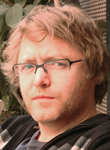Faculty fellow studies sound art of old recordings
By Kathy Hovis

Brian Hanrahan has a special appreciation for the crackle, fuzz and background chatter that characterize old radio broadcasts. To him, those sounds are as important as the content itself, maybe even more so.
Hanrahan, an American Council on Learned Societies New Faculty Fellow in the Society for the Humanities, has a teaching appointment in Cornell's Department of Theatre, Film and Dance and can often be found in his office with headphones on perusing the latest old recording he's uncovered.
A media historian and film scholar, Hanrahan has a background in German studies and taught media theory and history, contemporary cinema and German literature at Princeton University before coming to Cornell this fall.
"I spent lots of time listening to short-wave radio when I was growing up in Ireland," Hanrahan said. Later on, he developed an interest in the history of media and communication and a fascination with sound technologies of the late 19th and early 20th centuries.
"It's interesting to view old recordings as historical documents, as well as popular art forms of the time," he said, "and to think about how they were produced using the technology of the day."
These recordings form the basis for his book "The Vivid Thing in the Air: Liveness and Location on Weimar Radio," which is nearing completion. The book traces how new technologies in the interwar period -- devices like microphones, telephone relays, broadcast vans and mobile recorders -- gave access to the world outside the studio, allowing broadcasters to experiment with exterior sounds, live interviews and spontaneity.
To find recordings from this period, Hanrahan scoured European radio archives because most of these recordings still aren't available digitally or online.
One of his most inspiring finds was a German radio documentary that recorded events during a 1931 ship's voyage from Hamburg, Germany, to New York City. Using a new technology of that time -- portable disk recorders -- program-makers interviewed passengers and crew, recorded sounds of the ship arriving in New York and even radio broadcasts from the mainland that in those days seemed banal, but now offer glimpses into history, sound, accents and news from that time.
Hanrahan has a B.A. in intellectual history from Trinity College, Dublin, and a Ph.D. in German studies from Columbia. While in New York, he spent several years as producer and host with WKCR, a jazz and arts station affiliated with Columbia.
Hanrahan used the broadcast opportunity to interview many people whose work he had admired, including writers, directors, filmmakers and artists. "It was a fascinating experience," he said, "the hourlong format let them discuss their work in real depth and detail. Studio interviews are an intense way of encountering someone -- quite formal but intimate at the same time."
This semester, Hanrahan is teaching a seminar on Weimar cinema and in the spring will teach classes on media theory and on sound art.
"The fellows at the Society for the Humanities are tremendously fortunate that Brian's term as an ACLS New Faculty Fellow coincides with this year's research emphasis on "Sound: Culture, Theory, Practice, Politics," said Timothy Murray, Society for the Humanities director. "Brian joins a number of Society fellows who have primary interests in the history and theory of radio and has lent his exciting voice to our weekly seminar."
Hanrahan also researches German and European cinema. He is currently working on a series of essays on the film directors Klaus Lemke and Rudolf Thome, both initially associated with the 1960s Neue Münchener Gruppe. He has publications forthcoming on Walter Ruttmann's film-sound experiments, early portable recording technologies and Lemke's 1970s film comedies.
Kathy Hovis is communications manager of the Department of Theatre, Film and Dance.
Media Contact
Get Cornell news delivered right to your inbox.
Subscribe